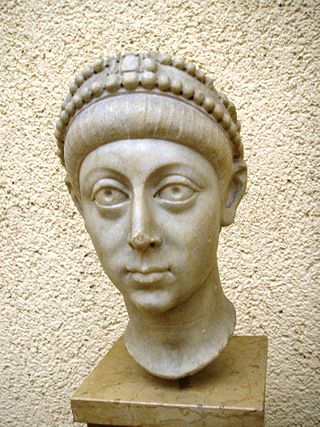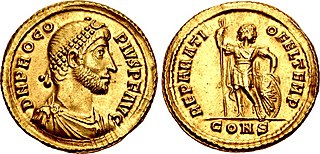Related Research Articles

Arcadius was Roman emperor from 383 to his death in 408. He was the eldest son of the Augustus Theodosius I and his first wife Aelia Flaccilla, and the brother of Honorius. Arcadius ruled the eastern half of the empire from 395, when their father died, while Honorius ruled the west. A weak ruler, his reign was dominated by a series of powerful ministers and by his wife, Aelia Eudoxia.
The 510s decade ran from January 1, 510, to December 31, 519.

Procopius Anthemius was the Western Roman emperor from 467 to 472. Born in the Eastern Roman Empire, Anthemius quickly worked his way up the ranks. He married into the Theodosian dynasty through Marcia Euphemia, daughter of Eastern emperor Marcian. He soon received a significant number of promotions to various posts, and was presumed to be Marcian's planned successor. However, Marcian's sudden death in 457, together with that of Western emperor Avitus, left the imperial succession in the hands of Aspar, who instead appointed Leo, a low-ranking officer, to the Eastern throne, probably out of fear that Anthemius would be too independent. Eventually, this same Leo designated Anthemius as Western emperor in 467, following a two-year interregnum that started in November 465.

Procopius was a Roman usurper against Valens.
The praetorian prefect was a high office in the Roman Empire. Originating as the commander of the Praetorian Guard, the office gradually acquired extensive legal and administrative functions, with its holders becoming the Emperor's chief aides. Under Constantine I, the office was much reduced in power and transformed into a purely civilian administrative post, while under his successors, territorially-defined praetorian prefectures emerged as the highest-level administrative division of the Empire. The prefects again functioned as the chief ministers of the state, with many laws addressed to them by name. In this role, praetorian prefects continued to be appointed by the Eastern Roman Empire until the reign of Heraclius in the 7th century AD, when wide-ranging reforms reduced their power and converted them to mere overseers of provincial administration. The last traces of the prefecture disappeared in the Byzantine Empire by the 840s.

Anthemius was a statesman of the Later Roman Empire. He is notable as a praetorian prefect of the East in the later reign of Arcadius and the first years of Theodosius II, during which time he led the government of the Eastern Roman Empire on behalf of the child emperor and supervised the construction of the first set of the Theodosian Walls.

The praetorian prefecture of the East, or of the Orient was one of four large praetorian prefectures into which the Late Roman Empire was divided. As it comprised the larger part of the Eastern Roman Empire, and its seat was at Constantinople, the praetorian prefect was the second most powerful man in the East, after the Emperor, in essence serving as his first minister.

In the Late Roman Empire, usually dated 284 AD to 641 AD, the regional governance district known as the Roman or civil diocese was made up of a grouping of provinces each headed by a Vicarius, who were the representatives of praetorian prefects. There were initially twelve dioceses, rising to fourteen by the end of the 4th century.

The praetorian prefecture of Italy was one of four praetorian prefectures into which the Late Roman Empire was divided. It comprised the Italian peninsula, the western Balkans, the Danubian provinces and parts of North Africa. The Prefecture's seat moved from Rome to Milan and finally, Ravenna.
Magnus was a Roman senator of Narbonne. He was appointed Roman consul in 460 by the Western emperor Majorian, at the same time Apollonius served in the East. Magnus also served as praetorian prefect of Gaul around the same time.
Agricola was a West Roman statesman who served twice as praetorian prefect and became consul for 421.
Flavius Taurus Seleucus Cyrus, better known as Cyrus of Panopolis from his birthplace of Panopolis in Egypt, was a senior East Roman official, epic poet, philosopher and a lover of Greek arts. He lived in Constantinople during the reign of Emperor Theodosius II.
Aurelianus was a prominent politician of the Eastern Roman Empire. He was praefectus urbi of Constantinople from 393 to 394, Praetorian prefect of the East from 399 to 400, and consul in 400. In 400, Gothic rebels under Gainas forced the emperor Arcadius to give them Aurelianus, and he was exiled; he returned to Constantinople after the defeat of the Goths later that year. He served as Pretorian Prefect to the East a second time from 414 to 416.
Flavius Taurus was a politician of the Eastern Roman Empire, Consul in 428.
Flavius Caesarius was a politician of the Eastern Roman Empire, who served under the emperors Theodosius I and Arcadius. Caesarius was magister officiorum (386-387), praetorian prefect of the East, and consul in 397.
Vitalian was a general of the Eastern Roman Empire. A native of Moesia in the northern Balkans, and probably of mixed Roman and Gothic or Scythian barbarian descent, he followed his father into the imperial army, and by 513 had become a senior commander in Thrace.
Flavius Taurus was a politician and a military officer of the Roman Empire. He was Praetorian Prefect of Italy and Africa, and consul in 361 AD.
Flavius Domnicus was a Byzantine military officer and patrikios, active in the reign of Emperor Justinian I. He should not be confused with his contemporary Domnicus, Praetorian prefect of Illyricum.
Marinus was one of the most trusted and senior aides of the Eastern Roman emperor Anastasius I. He served twice as praetorian prefect of the East, supervised some of Anastasius's tax reforms, supported the Emperor's pro-Monophysite policies and led the Roman navy in a crucial battle that ended for good the rebellion of general Vitalian in Thrace. He survived into the regime of Justin I, when he held his second tenure as praetorian prefect, but was soon sidelined from power.

The Eastern Roman Empire was ruled by the Theodosian dynasty from 379, the accession of Theodosius I, to 457, the death of Marcian. The rule of the Theodosian dynasty saw the final East-West division of the Roman Empire, between Arcadius and Honorius in 395. Whilst divisions of the Roman Empire had occurred before, the Empire would never again be fully reunited. The reign of the sons of Theodosius I contributed heavily to the crisis that under the fifth century eventually resulted in the complete collapse of western Roman court.